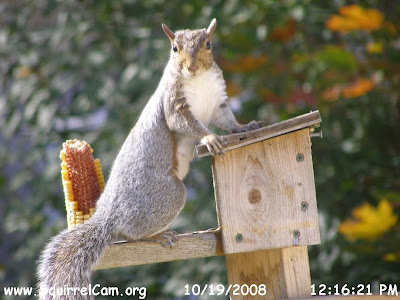Here is the shed I built last summer. Not so much related to the lake but may be interesting to some.
Tuesday, December 23, 2008
Thursday, December 18, 2008
Wednesday, December 17, 2008
Monday, December 15, 2008
Sebec Lake Ice-in
Thursday, December 11, 2008
Tuesday, December 9, 2008
Sea Smoke
Take an air temperature of 6F, a Water temperature 39F and what do you get?...Sea Smoke or Evaporation Steam Fog - It occurs when cold, dry air comes in contact with the relatively warm water. Over the ocean in polar regions where the air is extremely cold during winter, stream fog is referred to as arctic sea smoke.


Thursday, December 4, 2008
Tuesday, December 2, 2008
Lake water temperature

Watching the lake water temperature is proving to be very interesting. The water temperature sensor is a few feet below the surface. The lake has been calm recently and the water temperature has settled to a steady 39-40 deg F. Yesterday (Monday) was windy and you see a dip in the blue lake temperature line because mixing occurred which drove some of the cooler water near the surface down to the sensor. I would say if you measured the temperature from the surface down to the sensor on a calm day you would find the temperature profile to look like that shown in the chart below where you would read temperature from the chart from left to right as the lake temperature profile from surface to the probe ending at 4C (39.2F). (image from:http://www.marietta.edu/~mcshaffd/aquatic/sextant/physden.gif)
When the wind mixes the water we begin to see an indication of the surface temperature which is probably near or just under 35 deg F presently. When the wind stopped like today the water again re-statifies: warmer 39F deg water goes to the bottom and water cooler than 39F goes back to the surface.

Wednesday, November 19, 2008
Snow Squalls
You can see a couple of snow squalls move across the lake in the time-lapse video from yesterday. Click it now because it updates every morning and tomorrow this video will be replaced by today's time-lapse.
Saturday, November 15, 2008
Lake News
Nothing much to report. It's been cloudy and rainy at Sebec Lake. I'm working on new webcam software using the C# programming language and the Olympus developer SDK.
Wednesday, November 12, 2008
"Squirrel Proof" bird feeder
The squirrel is sniffing around the homemade bird feeder. We will see how squirrel proof it really is. I think he will dig under the pvc pipe to get in and and that case I my have to resort to replacing the wood base with something a bit more squirrel proof - like T60 aircraft aluminum. ...take that squirrel.

Monday, November 10, 2008
Sunday, November 9, 2008
Thursday, November 6, 2008
Another visitor: Northern Cardinal - Female

From birds.cornell.edu
The brilliantly colored Northern Cardinal has the record for popularity as a state bird: in the United States, it holds that title in seven states. This common bird is a winter fixture at snow-covered bird feeders throughout the Northeast, but it only spread to New York and New England in the mid-20th century.
Description
Medium-sized songbird.
Large crest on head.
Heavy, conical red bill.
Face surrounded by black.
Male entirely brilliant red.
Female grayish-tan with red tail and wings
Carolina Wren

From Birds.Cornell.edu
The Carolina Wren is sensitive to cold weather, with the northern populations decreasing markedly after severe winters. The gradually increasing winter temperatures over the last century may have been responsible for the northward range expansion seen in the mid-1900s.
Unlike other wren species in its genus, only the male Carolina Wren sings the loud song. In other species, such as the Stripe-breasted Wren of Central America, both members of a pair sing together. The male and female sing different parts, and usually interweave their songs such that they sound like a single bird singing.
One captive male Carolina Wren sang nearly 3,000 times in a single day.
A pair bond may form between a male and a female at any time of the year, and the pair will stay together for life. Members of a pair stay together on their territory year-round, and forage and move around the territory together.
Wednesday, November 5, 2008
Monday, November 3, 2008
Lake temperature plot
Saturday, November 1, 2008
White-Breasted Nuthatch - Automated capture
Friday, October 31, 2008
Thursday, October 30, 2008
Wednesday, October 29, 2008
Tuesday, October 28, 2008
Monday, October 27, 2008
Time Lapse Video
Saturday, October 25, 2008
Thursday, October 23, 2008
Bird visiting the squirrel feeder
Wednesday, October 22, 2008
Trip to Newfoundland - by Mike
In 2007 Jan and I drove to Newfoundland and Labrador, Canada. We took the Cat ferry from Portland, Maine to Yarmouth, Nova-Scotia. From there we drove the length of NS to Sydney. From Sydney we took another ferry to Port au Basques, NF and from there drove on to Gros Morne National Park. That journey takes 24 hours - if you time the ferry's right. There's a lot to see in Newfoundland. It's a wonderful place to explore, not crowded and has good camping and hiking. And if you go there be sure to try Bakeapple Pie with ice-cream - yum.
Now, if you go to live there as a transplant you gotta be "screeched in". To become an official "Newfie" you must drink a cup of Newfoundland Screech rum and kiss a codfish. Now when I was told this I thought that sounds a little too easy. I think you should have to jump into the cold water and swim around a bit. But why should I complain. :)
Sunrise at Sebec Lake

Sunday, October 19, 2008
Lake Level Update
 Bob Hall reports "Lake going down slowly ~ 0.5 inch/day (presumably in readiness to remove flashboards). Not having the south gate available to be opened is a real impediment; under the present conditions of water input to the lake, having that gate 'available' would increase the lake level drop rate to ~ 2.5 inches/day. The Ampersand folks do appear to be working to get it back into availabilty. (And to generate revenues - all the water presently going over the flashboards basically represent lost revenues for them)."
Bob Hall reports "Lake going down slowly ~ 0.5 inch/day (presumably in readiness to remove flashboards). Not having the south gate available to be opened is a real impediment; under the present conditions of water input to the lake, having that gate 'available' would increase the lake level drop rate to ~ 2.5 inches/day. The Ampersand folks do appear to be working to get it back into availabilty. (And to generate revenues - all the water presently going over the flashboards basically represent lost revenues for them)." Saturday, October 18, 2008
www.SquirrelCam.org - Progress
Ok, the squirrel cam is running at www.squirrelCam.org I detect a squirrel not by frame differences, ie. motion detection but by analyzing the spatial frequency content of a small region of interest (ROI) of each image in the place where the squirrel would be present. Because the camera is zoomed in tight and the resulting aperture is wide open, the focus depth of field is very small resulting in the far background being out of focus. The spatial frequencies present in that defocused background are low and when the squirrel is present the spacial frequencies of the well focused rodent are high. Taking the FFT of the ROI reveals the frequency spectrum of the ROI. Taking the absolute value of the FFT tells me what the relative magnitude of the spatial frequencies are. Low frequencies means bacground and high frequecies means foreground focused object. I set a mangitude threshold for the presence of a squirrel and presto, when he is there I save the image and post it. And that's my technical rant of squirrel detection :)

Somehow I've got to get inside the mind of the squirrel.. what are his habits, what makes him tick. Squirrelentology, the science of squirrel study, will hopefully be advanced by this webcam.

Making progress on the squirrel cam. Still testing the squirrel detection software.
-Mike
Wednesday, October 15, 2008
Halloween Moon !
Friday, October 10, 2008
Squirrels gone wild

Attention squirrel lovers and others. The squirrel cam is returning. Please stand by, it won't be long before those feisty squirrel antics can be viewed via the "best quality squirrel cam on the internet" ;)
I'm writing new software for squirrelCam.org that will be more reliable and also have better indication of when a squirrel is present. Last spring I was using a motion detection scheme. That involves looking at a difference metric between two consecutive frames. However that is not always very good measure of squirrel presence becuase there are other motions in the image that can trigger a detection such as wind blowing tree branches or changes in the lighting due to a cloud blocking the sun. Currently, I'm making a detection algorithm that will look at the statistics within a small region of the image (ROI) where the squirrel will be present. So, when this is completed I will put the camera online again. Shouldn't be too long now.
There is food at the feeder and a squirrel visited it but they seem to be so much more interested preparing for winter gathering nuts that they are not taking the time to sit and eat. Anyone know anything about squirrels habits?
Friday, October 3, 2008
Sebec Lake Webcam
Wednesday, October 1, 2008
Time Lapse Video
The time lapse video is automatically generated each night and then downloaded to the web server. It’s kind of fun to see how much can be done with limited bandwidth. The is dial-up has a data rate of of 56k baud and usually connects a bit slower than that. The camera is set up to take 4 images per minute x 60 min/hr x 12 hrs = 2880 frames in a movie.
The upload file is more than 10MB and the whole process takes a about 5 hours to complete. Think about the mars rover. It operates remotely (very) and does not have broadband comm back to earth. Looking it up I see the maximum downlink data rate from a rover is 11060bps or 11.06k. Our dialup is 56k. So, if they can do with 11k I think we can do ok with 56k.
Below is an example of a Sebec Lake Webcam time-lapse video. Go to www.SebecLake.net for the latest daily update.
The upload file is more than 10MB and the whole process takes a about 5 hours to complete. Think about the mars rover. It operates remotely (very) and does not have broadband comm back to earth. Looking it up I see the maximum downlink data rate from a rover is 11060bps or 11.06k. Our dialup is 56k. So, if they can do with 11k I think we can do ok with 56k.
Below is an example of a Sebec Lake Webcam time-lapse video. Go to www.SebecLake.net for the latest daily update.
Subscribe to:
Posts (Atom)


















